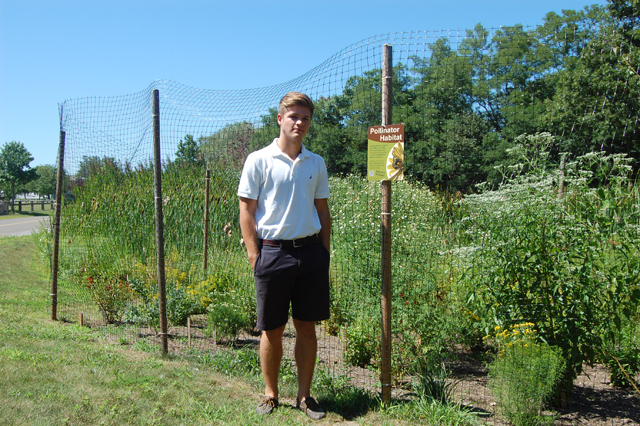For his Eagle Scout project, this Southold teen is saving the bees

Beginning in 2006, honeybee populations in America and Europe started to decline.
In what’s now called honeybee colony collapse disorder, or CCD, colonies were discovered with dead bees or no adult worker bees. Inexplicably, however, the colonies still had living queens and immature young bees and contained honey. According to the U.S. Department of Agriculture website, no scientific reason has yet been found for this die-off.
The USDA reports that the honeybee population dropped from 5 million in the 1940s to 2.5 million in 2013. As the numbers continue to decrease, however, the demand for honeybees is increasing, creating a larger problem.
After learning about CCD, 18-year-old Zachary Ellis of Southold decided to take action by dedicating his Eagle Scout project to preserving these and other insect species, a project he’s been looking forward to since he became a Boy Scout at age 12. To do so, he created a 300-square-foot pollinator habitat at Peconic Landing in Greenport.
“It created a unique opportunity for different generations to work together,” said Robert Syron, president and CEO of Peconic Landing. “Zach’s enthusiasm meshed well with our residents’ and the organization’s concern for the environment. We are always looking for environmentally sound ways of beautifying our campus.”
The habitat occupies a fenced-off stretch of land next to a pond on Brecknock Road. It is filled with plants of all shapes and sizes, each labeled with a wooden stake and frequented by butterflies and numerous insects.
According to the USDA, a pollinator habitat is an area of vegetation suitable for pollinating animals — including birds, bees, butterflies, bats and others — to live.
“It’s so important because we’ve had a dramatic decrease in the number of pollinators,” said Zach, a recent Southold High School graduate. “So giving these pollinators a place to kind of all come together to pollinate, it helps to possibly increase the number of pollinators, which is so important.”
In order to create a successful habitat, Zach worked under the guidance of next-door neighbor Alan Connell, who works for the USDA natural resources conservation service.
Mr. Connell stressed the importance of these habitats, especially in light of CCD. Currently, the honeybee population is diminishing by 33 percent each year, with one-third of that decline attributed to CCD, according to the USDA. This continued decrease could lead to increased costs for honeybees to be used for pollination, which could ultimately lead to higher food costs for consumers.
“Prior to World War II, that’s all our crops were pollinated through — native pollinators,” Mr. Connell said. “Then we slowly evolved to using the honeybee as our workhorse for pollination of our crops and because of this die-off, it’s shown a real need for not only creating habitats for our crops but also for our backyards too, so that we have food for the future.”
Mr. Connell explained that this die-off appears to be caused by increased pesticide use. Because of this, Zach hopes his project makes others more aware of how their actions affect native pollinators.
“I really wanted to try and get that word out and make a project like this and have it spread so everyone else can maybe do something similar like this in their own house or any kind of property,” Zach said.
Together, he and Mr. Connell created a list of flowering plants for the garden that would sustain local pollinators, including baccharis, bee balm, switch grass and goldenrod.
According to Jim Glover of Glover Perennials in Cutchogue — who donated the plants for the habitat — these were chosen because they’re native to the area.
“It’s well known now through research that native plants attract native pollinators far better than non-natives do,” he said. “So if planning for a pollinator garden, certainly a lot of natives should be incorporated into the garden.”
Mr. Glover added that native plants are important if you want birds on your landscape, since they attract insects that the birds feed their young.
In addition to securing the donation of the plants for his Eagle Scout project, Zach had to meet with board members at Peconic Landing, plan the area and plant the garden — a process that took nearly four months and was made possible with the help of family, friends and fellow scouts.
“Zach was really great,” Mr. Connell said. “He did all of the organization, he got the volunteers and he did all the work. I just fed him the information he needed and he ran with it. He did a really great job.”
He also worked with residents of Peconic Landing eager to participate in creating the retirement community’s new addition.
“About a dozen members actually formed a committee to help Zach,” Mr. Syron said. “Together, they will be doing educational seminars for the public about the need to rebuild pollinator habitat. The hope is to invite students from local schools to learn about our local environment and have our residents on hand to help teach.”
Photo Caption: Zachary Ellis stands next to the Pollinator Habitat he made at Peconic Landing as part of his Eagle Scout project (Credit: Nicole Smith).








